May 5, 2012
by Robin Parker -
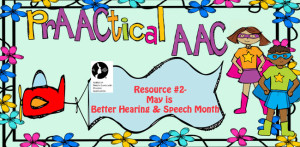
We love when our students are kept up to date with current events. Often times, current events are not explained to students with significant communication challenges because the language surrounding the event seems “complicated” or “too high” (not actually our words but unfortunately ones we have heard). However, we know ALL our students understand some aspects of major current events because that is what everyone around is talking about (back in the day… American Idol winners or the Super Bowl, or even just the anniversary of the Titanic Tragedy). So it is great when we have access to symbol based newspapers that take complicated topics and make them more concrete and then add symbols so we do not have to do all the work. We love News- 2- You which includes various activities, levels, recipes, and even jokes. The ONLY problem with News-2-You is the price (We think it is... [Read More...]
Filed under: PrAACtical Thinking
Tagged With: current events, resource, symbol newspaper
May 4, 2012
by Robin Parker -
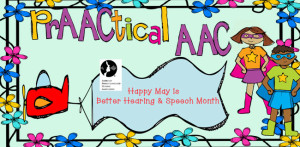
In Honor of Better Hearing & Speech Month Spread the Word: Speech and Hearing is more than Speech and Hearing. We love to make sure to talk about communication and language as well. Thanks to the Communication Trust for Great Tips on Facilitating ALL Types of Talking & putting them in poster ready format! Look for daily (or as close as we can get) resources related to PrAACtical AAC & Better Speech and Hearing Month.
Filed under: PrAACtical Thinking
Tagged With: communication, Communication Trust, resources, Speech & Hearing Month
May 2, 2012
by Carole Zangari -
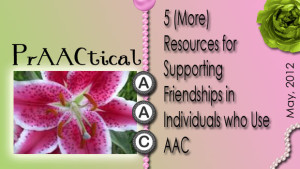
– 1. We love this article by ConnectAbility on helping children build friends. – 2. Online connections can be fun, too. AAC Small Talk is a Yahoo group for kids who use AAC and their friends. It’s hosted by Pam Harris and Dr. Jill Senner. – 3. Games and friends go hand-in-hand, but sometimes a little adult support is needed. We really liked the ideas in this post by SLP Tahirih Bushey on how to choose and play games that build communication: http://bit.ly/J3IMtM 4. Novita Children’s Services has some wonderful information about helping friendships to develop: http://bit.ly/HQQoMD – 5. Explaining AAC to a child’s friends and classmates doesn’t have to be hard! We love this PowerPoint by master AAC clinician Gail Van Tatenhove. She wrote it for students in inclusive classrooms to introduce Minspeak so that they can be good communication partners for their friends who use AAC. – . Want to see our... [Read More...]
Filed under: PrAACtical Thinking
Tagged With: friendship, resources
May 1, 2012
by Carole Zangari -
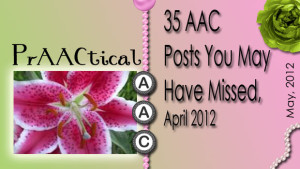
— – – Strategy of the Month From Disney Princesses to Houseplants: More on Building Communication Opportunities 5 Apps for Tempting Commenting and Other Language Functions Go Ape! 10 Commenting Communication Temptations PrAACtical Play: Creating Communication Opportunities with Favorite Toys How to Make Communication Temptations Really Work Mining Preschool Routines for PrAACtical AAC Opportunities. Meaningful Communication Opportunities – The Fives 5 ‘Go-To’ Sites for AAC and Visual Support Downloads 5 Apps for Tempting Commenting and Other Language Functions 5 AAC-Related Facebook Pages/Groups We Love 5 Tools and Tips for Making Transitions Easier 5+ Sites for Free AAC-Friendly Literacy Resources 5 eGames for Switch Users 5 AAC/AT YouTube Channels We Love – PrAACtical Thinking 49 Free or Lite Versions of AAC Apps A Myth About Visual Schedules Lives On PrAACtical Resources: Making Decisions about Reading Accessibility Options PrAACtical Resources: Toolkit for ASD PrAACtical Questions: How Do I Find Good AAC Service... [Read More...]
Filed under: PrAACtical Thinking
Tagged With: intervention, Opportunities, resources, visual schedule
April 30, 2012
by Robin Parker -
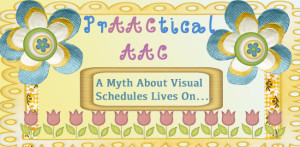
Nooooo, not again. A myth about visual schedules continues to rear its ugly head in a prAACtical situation (maybe we can reframe it into a learning opportunity??). Some history- A parent of twin girls with autism (age 15 and two other younger children– yes total 4) stopped by our office to pick up some autism awareness materials yesterday (a super busy mom in so many ways —going out of her way to help our community). As we were exchanging pleasantries and getting updates on how the girls were doing, we heard something that continues to surprise us–(and not in a good way). What did we hear? We heard that the girls were doing relatively well (not the surprising comment) but that mom was extra busy because the girls were no longer independent in taking their showers. They could do it by themselves but didn’t like the sensory input of soap... [Read More...]
Filed under: PrAACtical Thinking
Tagged With: mini schedules, myths, schedules, visual supports
April 30, 2012
by Carole Zangari -
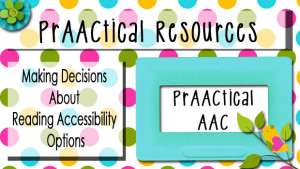
It’s easy to daydream when you’re sitting in the sun. It is a stunningly beautiful day here in south Florida. “Too nice to stay indoors,” my mom would have said, and so I’m sitting outside with my laptop working away. Before long, my mind starts to wander. – Ever think about what you would do if you weren’t an SLP? For me ‘reading teacher’ would be pretty close to the top of the list. – I was one of those kids who spent hours in the children’s library just devouring books. Melinda Cox Free Library was my home away from home, and In those days it was run by the Edgar sisters, Miss Martha and Miss Alice. They tolerated no nonsense in ‘their’ library and the adult books were strictly off-limits to young people. We were confined to the Littleton room, a well-stocked children’s section, where I spent most of... [Read More...]
Filed under: PrAACtical Thinking
Tagged With: assessment, literacy, reading
April 29, 2012
by Carole Zangari -
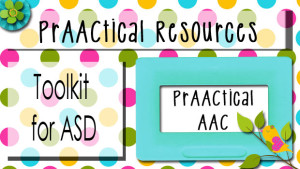
– Where do you go after the diagnosis? Special Needs Resource Magazine has two amazing resources for families whose children were recently diagnosed with ASD. They shared two Autism Speaks’ guides, Autism and Asperger Toolkits for Families, both of which provide direction for the first 3 months after diagnosis. Each one contains lots of helpful information by respected professionals, such as Lynn Koegel, Wendy Stone, and others. There are very prAACtical tips, including an action plan, useful forms, and a safety guide. –
Filed under: PrAACtical Thinking
Tagged With: ASD, resources
April 28, 2012
by Carole Zangari -
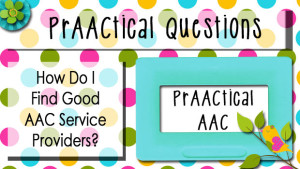
AAC is a field that involves many different disciplines, including OT, PT, SLP and education. In the best-case scenario, professionals in these disciplines work together to evaluate and provide intervention for the individual with little or no functional speech. If that option is not available, consider what discipline makes sense in your particular situation. For example, individuals with complex motor impairments may be best served initially through an OT who knows how to identify the best means of accessing AAC devices as the primary AAC service provider. For a child who is just learning to communicate, a speech-language pathologist (SLP) may be the best person to coordinate AAC services. A comprehensive AAC evaluation will always have the SLP playing a central role, which is important because of the special knowledge that they have about language and communication. How do you find an SLP with adequate skills in AAC? While there... [Read More...]
Filed under: PrAACtical Thinking
Tagged With: assessment, FAQs, SLP
April 27, 2012
by Carole Zangari -
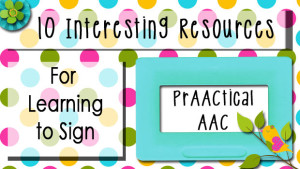
1. My Smart Hands has resources on their website and also a sign dictionary app. (There’s a Lite version, too.) 2. Sign to Talk: ASL signs (150 nouns and 40 verbs) 3. ASL Dictionary: Over 4800 ASL signs 4. Sign 4 Me: Translates from English to Signed English, ASL 5. iASL: Conversion from English to ASL 6. ASL Lite: Free Android app with 100 ASL signs 7. iSign: 800+ ASL phrases 8. Signing Time Lite: Free flashcard-type app for teaching signs to young children 9. Sign Me a Story: Signed stories for little kids 10. Baby Sign and Learn: Free app for teaching signs to young children. Choose from various sign languages: American Sign Language (ASL), Australian Sign Language (Auslan), British Sign Language (BSL), Hong Kong Sign Language (HKSL) and New Zealand Sign Language (NZSL). – –
Filed under: PrAACtical Thinking
Tagged With: Apps, manual signs, signing
April 26, 2012
by Carole Zangari -
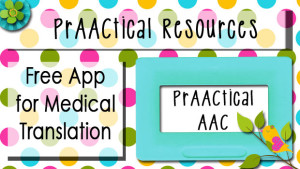
– Conversations with health care providers can be confusing, particularly when medical terminology comes into play. But what if you and your doctor literally speak different languages? Yup, there’s an app for that. – Medibabble is an app that translates thousands of medical questions and instructions into five different languages (English, Spanish, Cantonese, Mandarin, Russian, Haitian Creole). The Spanish language option is preinstalled and the rest are easy in-app downloads. The app itself and all the languages are free. – The main feature is a large database of questions, answers, and patient instructions that are organized by body systems (e.g., respiratory, digestive) and symptoms to allow medical staff to gather accurate case history information and convey information. There are also greetings/farewells, introductions (e.g., “I am your physical therapist), common responses (e.g., “Thank you for answering my questions”), and explanations (e.g., “Since an interpreter is not available immediately, this device will allow... [Read More...]
Filed under: PrAACtical Thinking
Tagged With: Apps, Medical, resources









